
Is Straw Bale Gardening the Best Gardening Method?
Creating a backyard garden is an exciting and fulfilling adventure, but filling raised garden beds can become expensive. Luckily there are a few types of gardening that will not only help to reduce costs but improve the quality of the soil over time! The top three methods include straw bale gardening, the lasagna gardening method, and Hügelkultur raised bed gardening. Each of these no-till gardening methods includes components that will decompose, but there are distinct differences. Each method has its benefits and challenges, so use this guide to determine which method is right for you.
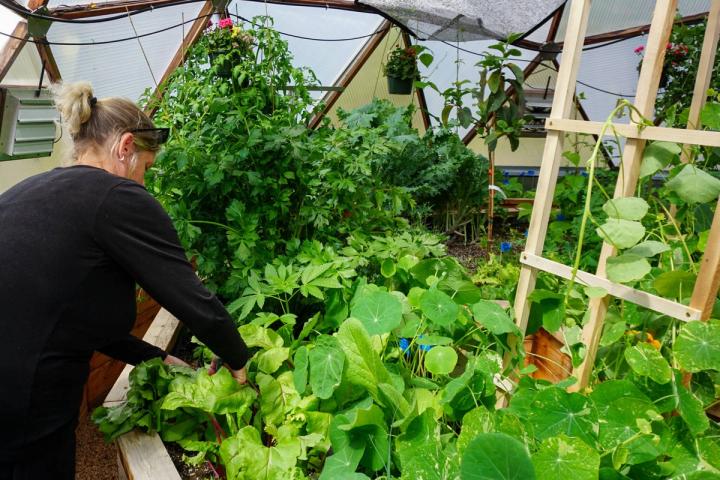
Straw Bale Gardening
What is Straw Bale Gardening?
Straw bale gardening utilizes a straw bale as the main growing medium topped with quality compost to grow vegetables. The use of high nitrogen fertilizer jump starts the breakdown of the straw bales.
Benefits of Straw Bale Gardening

This gardening method is quicker to establish than Hügelkultur raised bed gardening. The straw takes far less time to decompose than wood. This method also requires fewer resources and can be easily sourced regardless of location. Straw can be purchased from a local feed store or garden supply. We used a local feed supply store, but you can also use the Colorado Weed Free Forage website to find a local farmer. It is important that the straw be organic and not treated with herbicides or pesticides.
How to Build a Straw Bale Garden
- Solarize the straw bales. Wrap the bales in black plastic and allow them to sit in the sun for a few days. This process will kill off many pests or seeds that may be present in the bales. It is important to use straw and not hay to limit the amount of seeds that are present in the bales.
- Place them into the raised garden beds with the cut edge oriented vertically. Remove the baling twine. If using this method to fill irregularly shaped or tall raised beds, break a few bales apart to fill in the gap between the top of the bales and the top of the raised beds.
- Condition the straw bales. Pierce the straw bales with a pitchfork to make sure that the fertilizer will disburse through the bales. Follow these fertilizer guidelines, watering thoroughly after each application:
- Days 1-6 – ½ cup high nitrogen fertilizer per bale
- Days 7-9 – ¼ cup high nitrogen fertilizer per bale
- Day 10: 1 cup of a well-rounded fertilizer per bale* (we used a 4-4-4 blend with mycorrhizae)
- Place quality compost on top of the straw bales and water again.
- Once the temperature of the straw bales has decreased to 100 degrees or below, plant as you wish!
*Turn loose straw, if used, before adding the final conditioning treatment to ensure the high nitrogen fertilizer penetrates to the bottom.
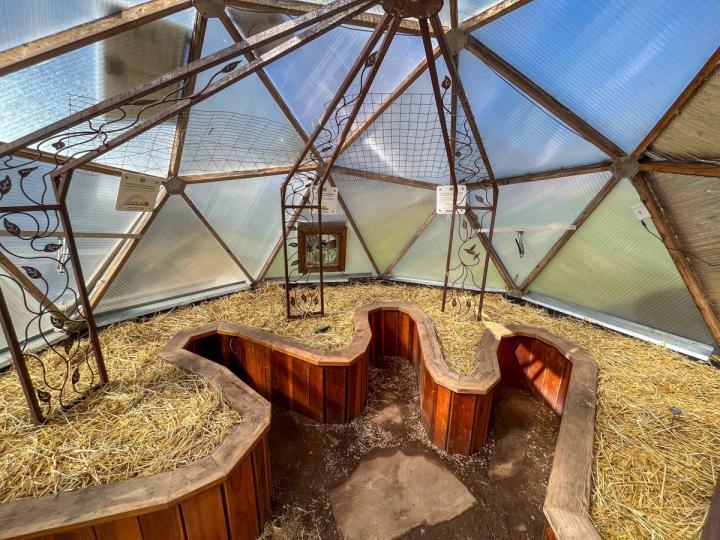
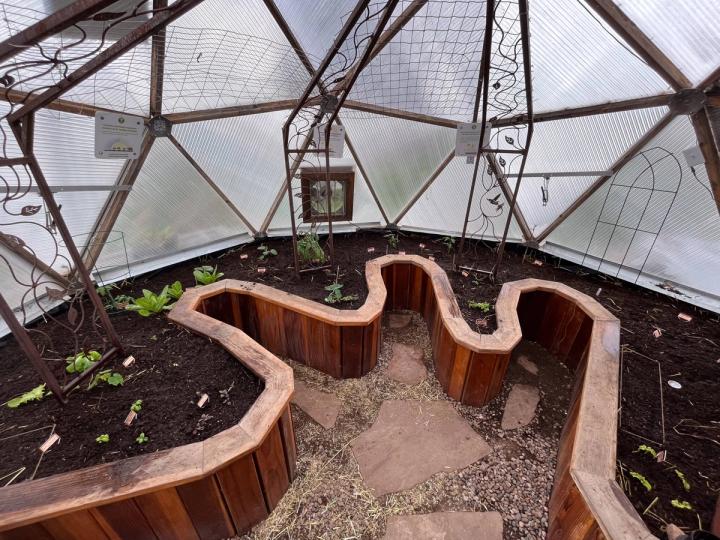
Straw Bale Gardening Planting and Maintenance
Many plants grow well with this method. You can grow everything from root vegetables to cucurbits to leafy greens. Seeds can be direct-sown or you can transplant seedlings when using the straw bale gardening method. When transplanting you may find that you need to make a hole in a straw bale for the root ball to fit. Make this hole slightly larger than the root ball and fill it with a bit of compost prior to planting. You can also use a root stimulator to help prevent transplant shock. Use a stake or trellis long enough to penetrate all the way through the bale for tall plants to ensure stability.
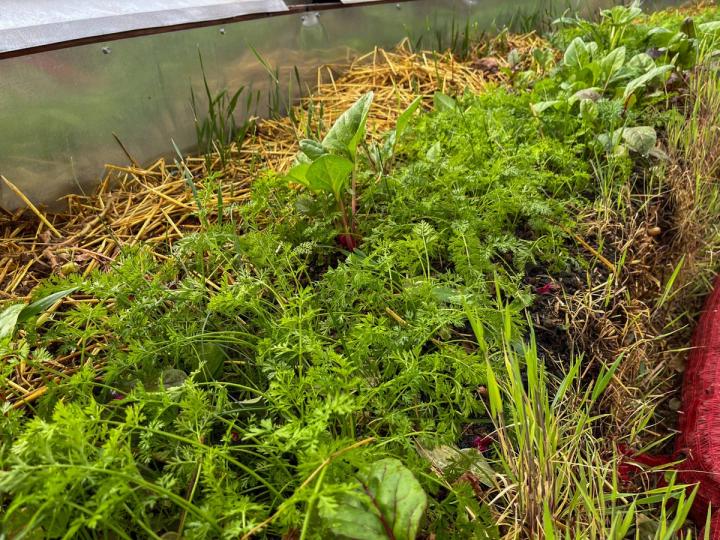
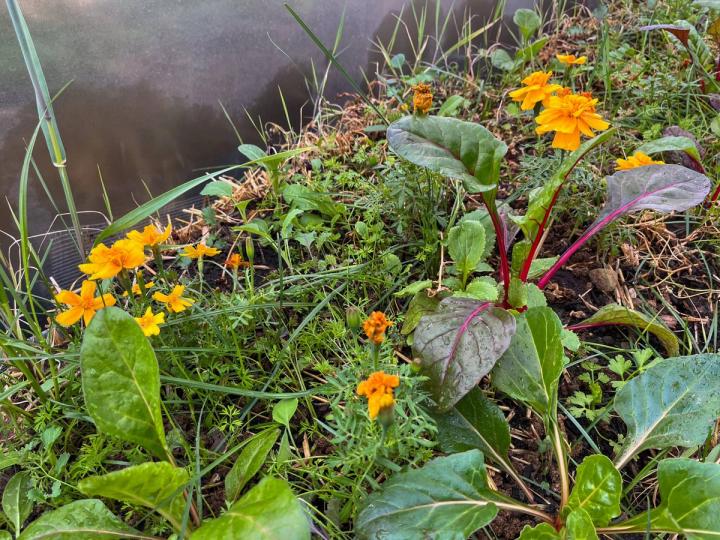

As the straw breaks down and the beds settle, you may notice gaps between the bales. You can fill any gaps with more compost or topsoil as they appear. You can also break up the bales completely after 1 year and start the process again on top of the existing organic matter.
Challenges of Straw Bale Gardening
The main challenge with straw bale gardening is water and volume loss. This method requires consistent watering during the conditioning process. As the straw breaks down, you will need to top off the beds with more compost and/or add more bales for the next year.
Despite this being an ongoing process, this gardening method is extremely cost-effective. We filled a garden bed that would have required 9 cubic yards of soil with 17 straw bales and bags of compost. Including the fertilizer used to condition the bales, we spent less than $260 in total. Even though we will continue to top with compost and may need to repeat the process again in the future, this is about a $3,000 savings compared to utilizing high-quality topsoil.
Hügelkultur Raised Bed Gardening
What is Hügelkultur?
Hügelkultur is a permaculture gardening technique that has been popular in Germany for centuries. It translates to “mound culture” or “hill culture” in English and is most often done outdoors. The technique comprises a base of large logs, topped with smaller sticks and garden “waste” such as leaves or clippings. This base is topped with compost and topsoil and allowed to decompose over time. The basic concept can be adapted to fill raised garden beds.
Benefits of Hügelkultur Raised Bed Gardening
This method is great for those who are looking for an inexpensive option to fill raised garden beds. If you need to remove trees to build your backyard garden, or for wildfire mitigation, then you are in luck! The process of burying logs helps to sequester carbon and is better for the environment than burning it.

As the wood begins to decay it will help to retain moisture and thus requires less watering in the long run. You are essentially creating a living sponge. The majority of water is stored in the rotting wood at the bottom of the “mound.” This will essentially create a “bottom watering” system where your plants will absorb the water and nutrients from below instead of needing to be consistently watered from above.

This style of gardening creates an environment for microbes, bacteria, fungi, and worms that all help to enrich the soil. This living network in the soil is why this method is a “no-till” method. Tilling would disturb this delicate ecosystem within the soil.
How to Build a Hügelkultur Raised Bed
- Collect logs and lay them horizontally. It is best to use wood that is already starting to rot as this will speed up the process. Oak and birch work well in Hugelkultur raised beds. Allelopathic trees, such as black walnut, or trees that are rot-resistant, such as redwood and cedar, should be avoided.
- Top the logs with smaller branches and twigs.
- Top the wood with organic material using the lasagna gardening method.
- Water thoroughly. Make sure to saturate all the layers.

Hügelkultur Raised Bed Planting and Maintenance
As the wood decomposes it will remove nitrogen from the soil that many plants need. It is ideal to plant legumes the first year to help fix nitrogen back into the soil for future crops. Squash and cucumbers are also good first-year plants to grow in a Hügelkultur raised bed. Melons and potatoes also do particularly well.
Challenges of Hügelkultur Raised Bed Gardening
Time. While you can use your Hügelkultur raised beds immediately, the benefits increase as time goes on. It can take 2-3 years for the wood to decompose and as this happens, if you are gardening in raised beds, you will need to top off the beds with more compost and/or topsoil to maintain the height.
Heat. Organic materials heat up as they decay. This is great for winter gardening but is something to be mindful of in the summer months.
Moisture. In order to speed up the decomposition and the soil enrichment that comes with it, the beds need to be constantly wet. This can be a challenge to those who have built their raised garden beds out of wood. If your beds are already built out of wood, line them with a moisture barrier to prevent rot. If you are planning your garden and are thinking about using Hügelkultur methods, it is best to construct your raised garden beds out of non-porous materials such as rock, stone, or cinder blocks.
Pests. Decomposition is the name of the game when it comes to Hügelkultur. With decomposition comes roly pollies and slugs among others. These little guys are not inherently bad as they do their job of decomposing very well, but they can become a nuisance when they feed on your tender seedlings. The other pest to be aware of, depending on your location, is termites. Choose your logs carefully if you will be using this method in a wooden raised bed or greenhouse.
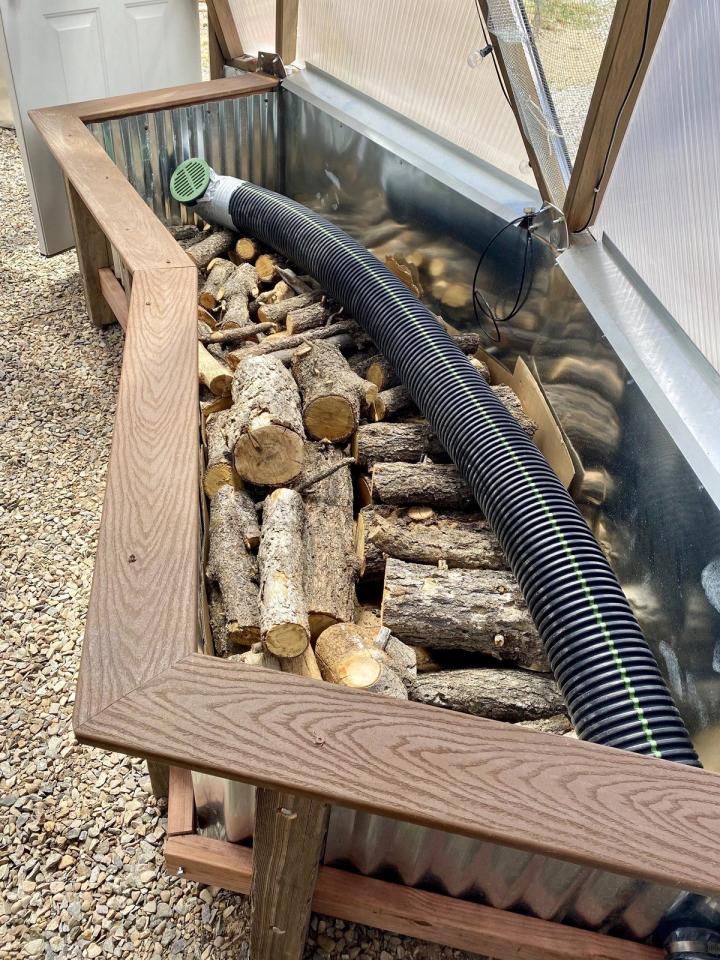
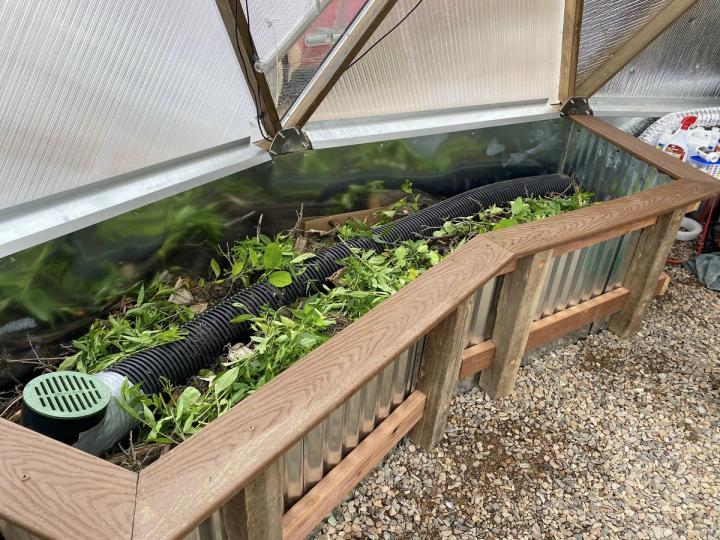
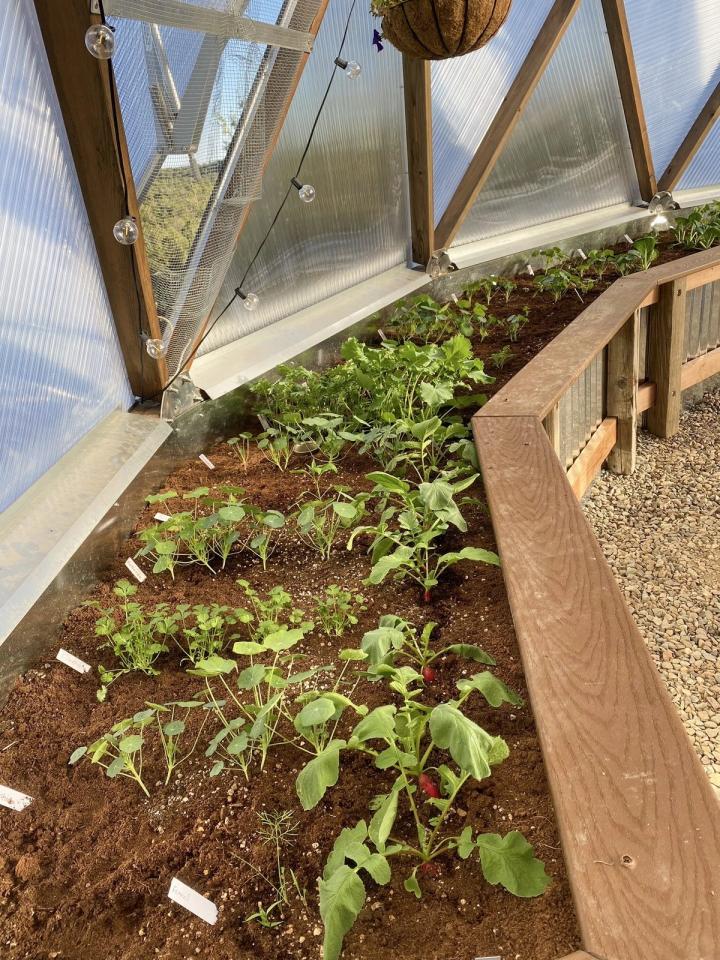
Read more about how Hugelkultur Gardening is used in a 26′ Growing Dome Greenhouse in Southwest Colorado.
Lasagna Gardening Method
What is the Lasagna Gardening Method?
The lasagna gardening method, also called sheet mulching, is a permaculture practice that utilizes layers of brown and green materials to essentially create compost without the need for a separate bin. Once the materials break down, you can plant directly in the nutrient-rich compost.
Benefits of the Lasagna Gardening Method
This gardening method helps with water retention because compost can hold more moisture than regular soil. It is also rich in nutrients that will supply your plants with everything they need without the need for added fertilizers.
The lasagna gardening method helps to reduce waste by utilizing yard, kitchen, and garden scraps that may otherwise end up in the landfill.
How to Build a Lasagna Garden
- Obtain “brown materials” (shredded leaves, cardboard, newspaper, peat moss, and coffee grounds) and “green materials” (vegetable scraps, grass clippings, garden trimmings).
- Place a layer of cardboard at the bottom of your raised garden bed.
- Layer “brown” and “green” materials alternating with every layer. Your “brown” layers should be twice as deep as your “green” layers to create the proper balance of carbon and nitrogen.
- Moisten all materials. This will create the conditions necessary for the materials to break down.
- Wait a few weeks for the materials to begin to break down and create compost. Once the materials are uniform, you can begin planting.

Lasagna Gardening Method Planting and Maintenance
Keep the beds moist until they have decomposed to your liking to ensure proper compost creation. Once the beds have been planted, water and weed as you normally would. Because you are likely using a lot of organic materials, there will likely be some seeds present that can germinate. Avoid adding weeds to the “green” mix for this reason.
Challenges of the Lasagna Gardening Method
This gardening method, like all gardening methods, comes with its own set of challenges. You will need to collect all the materials, enough to produce 4’ tall beds since they will reduce in size by at least half as they decompose. You won’t need all these materials at one time, but you should account for needing to repeat the layering process at least once a year.
This is a slow process. The decomposition time of materials can vary depending on your location and this can also be a smelly process. If you are doing this in a greenhouse, this is something to be aware of. However, if you wish to plant right away you can add a thick layer of topsoil to plant in. Remember, you are essentially creating a compost pile and that also comes with decomposers like pill bugs.
What is the Best Gardening Method in a Greenhouse? Straw Bale Gardening, Hügelkultur Raised Bed Gardens, or the Lasagna Gardening Method
That decision is up to you! All of these methods have their benefits and challenges, but there is sure to be something that will help you accomplish your goals. We have seen Growing Dome owners use all these gardening techniques with great success. Check out our customer’s raised bed designs for inspiration and advice on how to fill your raised garden beds. A vermiculture system is also a great addition to any garden regardless of the growing method.
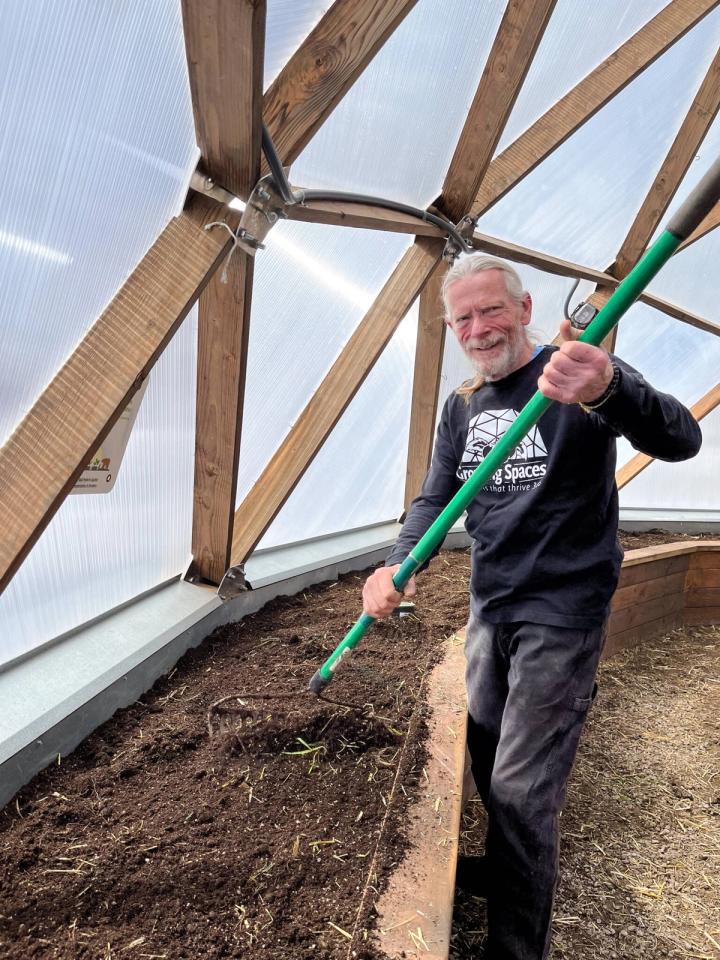
Consider the resources that you have available to you in making your decision. If you have plenty of logs and branches on your property, Hügelkultur may be the best option for you. You may have an excess of green leaves, garden trimmings, and plenty of browns, therefore the lasagna gardening method may be the way to go. However if you are looking for a quick, easy, cost-effective solution and do not have the aforementioned available, try straw bale gardening!
If you’d like to share your feedback on these or your favorite gardening methods, please do so in the comments below. A greener future awaits you. Go forth and garden!
Share This

Social Media Coordinator
I graduated from Fort Lewis College in 2018 with a BA in Environmental Studies. I began working for Growing Spaces in August of 2020 and have had the pleasure of working in many departments. I enjoy being a part of this amazing team that helps others achieve their dream gardens! In my spare time, I enjoy working in the 15’ Growing Dome that my husband and I share.
Subscribe to Our Newsletter
Join our community to stay up to date

Featured Categories
Downloads

Please Subscribe to Our Newsletter! :-)
Please Join our community to stay up to date :-)
